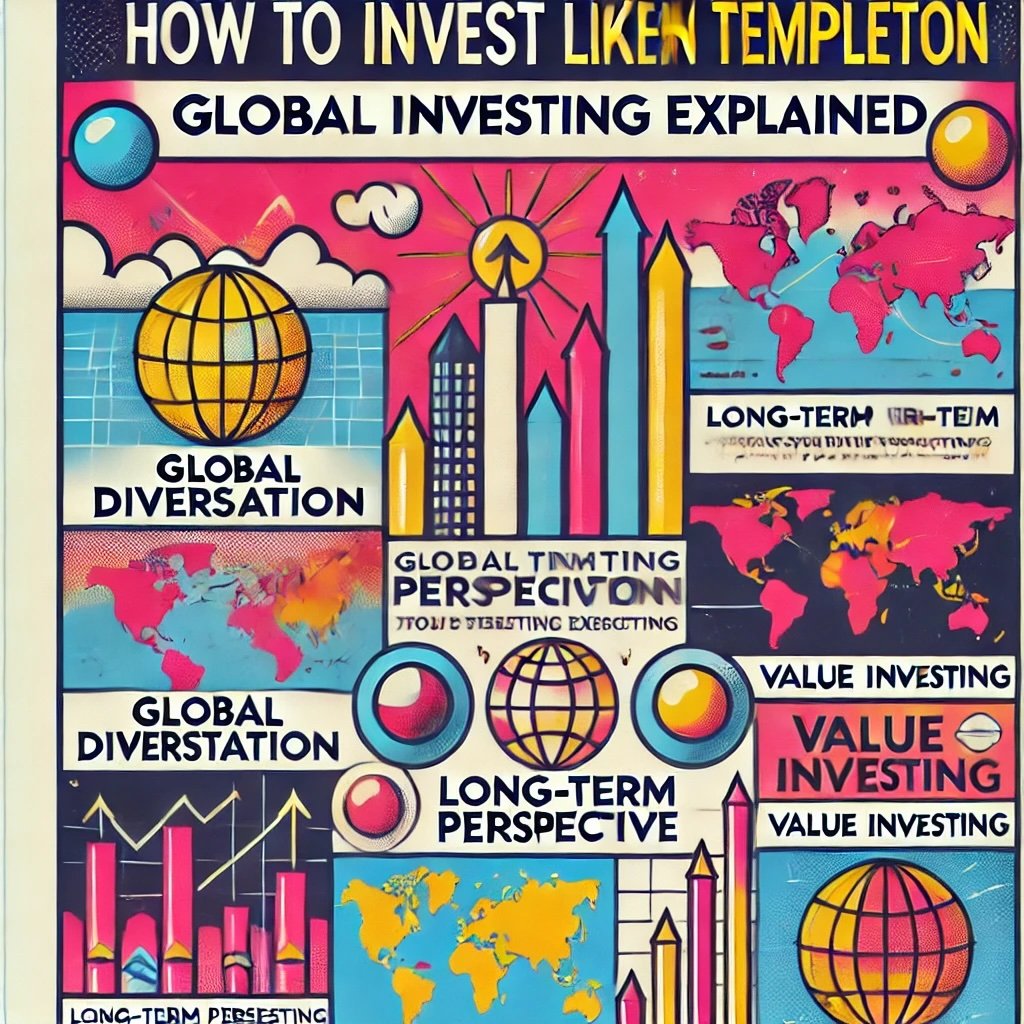Investing like Paul Tudor Jones isn’t just about crunching numbers or following market trends—it’s a sophisticated blend of strategic insight, disciplined risk management, and a deep understanding of global macroeconomic forces. Whether you’re a seasoned investor or just beginning your trading journey, adopting Jones’s contrarian macro trading strategies can provide a fresh and potentially lucrative perspective on navigating the financial markets. In this comprehensive guide, we’ll delve into Paul Tudor Jones’s trading philosophy, dissect his core strategies, and offer actionable insights to help you emulate his success in the world of contrarian macro trading.
source: Cooper Academy on YouTube
Paul Tudor Jones: A Legendary Figure in Trading
Paul Tudor Jones is a name synonymous with trading excellence and financial acumen. As the founder of Tudor Investment Corporation, Jones has built a reputation for his ability to anticipate market movements and capitalize on them with remarkable precision. His influence extends beyond his impressive track record; he is also renowned for his philanthropic efforts and commitment to mentoring the next generation of traders.
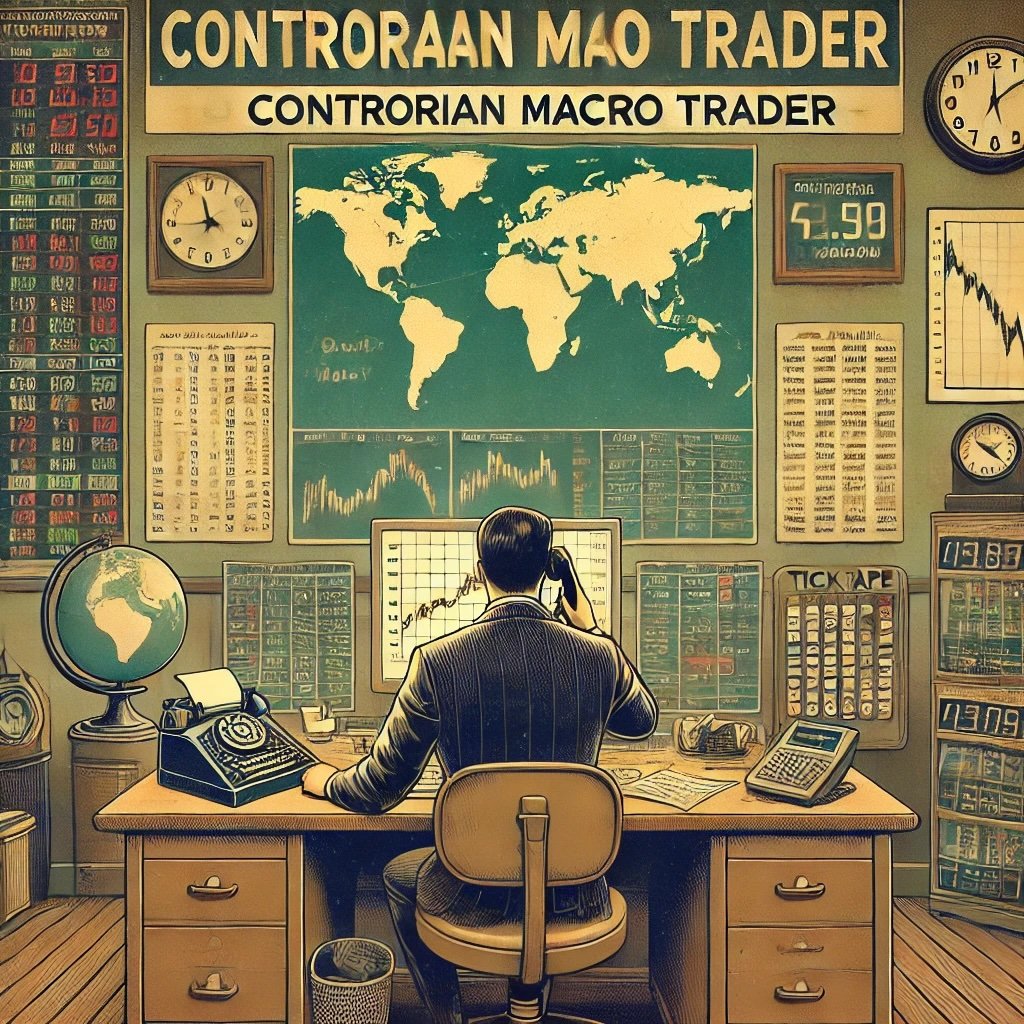
Contrarian Macro Trading: An Unconventional Approach
At the heart of Jones’s success lies his adoption of contrarian macro trading. Unlike conventional strategies that follow prevailing market sentiments, contrarian traders seek opportunities by taking positions opposite to the general consensus. This approach requires a keen understanding of global economic indicators, geopolitical events, and market psychology—areas where Jones excels.
We’ll attempt an in-depth exploration of Paul Tudor Jones’s trading strategies and philosophy. By dissecting his approach to contrarian macro trading, we will uncover the principles that have driven his sustained success and offer practical guidance for investors looking to implement similar strategies in their own portfolios.
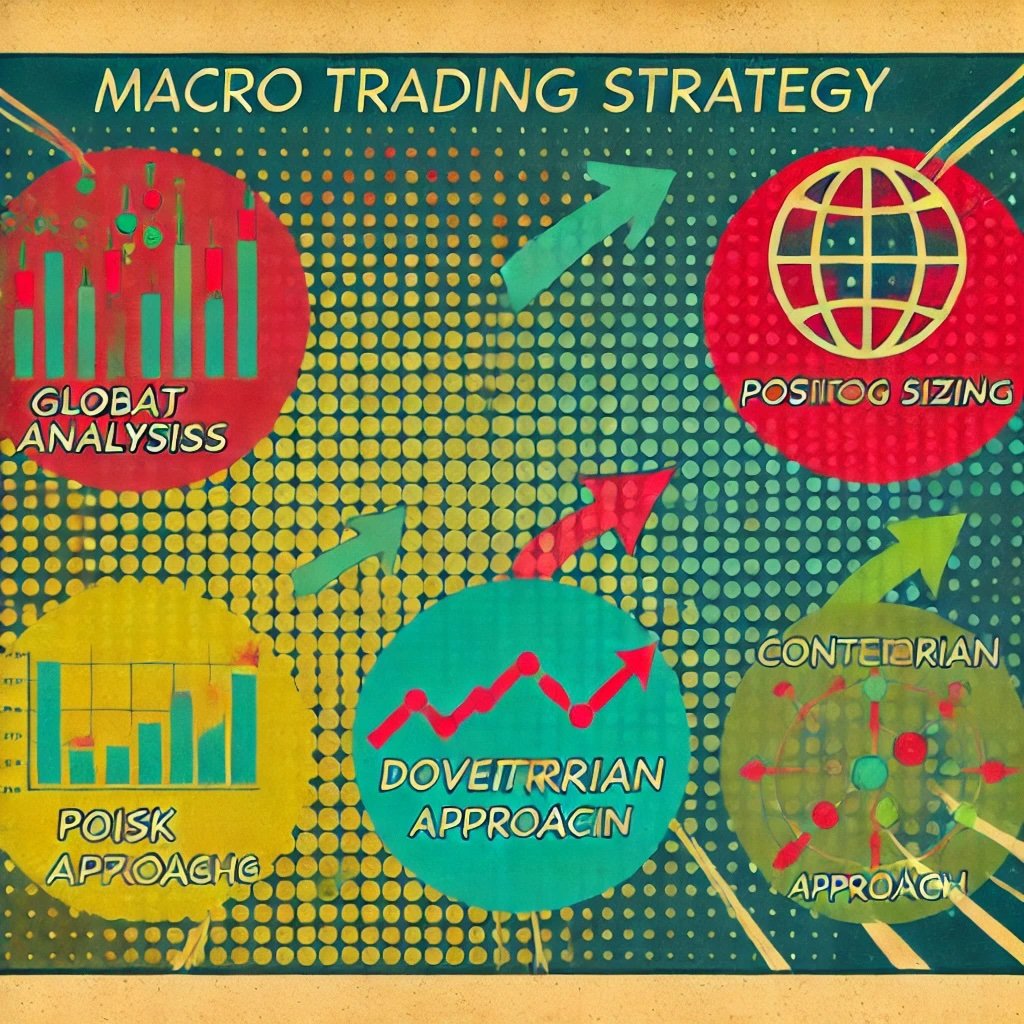
Who is Paul Tudor Jones?
Early Life and Background
Paul Tudor Jones II was born in Memphis, Tennessee, in 1954. From a young age, Jones exhibited a keen interest in the financial markets, a passion that would eventually shape his career. After graduating from the University of Virginia with a degree in economics, Jones embarked on his journey in trading, starting at the Arnhold and S. Bleichroeder brokerage firm.
Jones’s early career was marked by his innate ability to predict market movements, a skill that quickly set him apart from his peers. In 1980, he founded Tudor Investment Corporation, a private asset management firm that would become a cornerstone of his trading legacy.
Rise to Prominence
Jones’s rise to prominence was meteoric. His reputation as a skilled trader was solidified by his performance during the stock market crash of 1987, famously known as Black Monday. Jones correctly anticipated the market downturn and positioned his portfolio to benefit from the ensuing decline, resulting in substantial profits. This move not only protected his clients’ investments but also cemented his status as a top-tier trader.
Over the years, Jones has consistently delivered impressive returns, navigating various market cycles with aplomb. His ability to adapt to changing market conditions and his unwavering commitment to his trading principles have been key factors in his enduring success.
Key Achievements
- Black Monday Trade (1987): Jones’s foresight during the 1987 crash is perhaps his most celebrated achievement. By shorting the market ahead of the crash, he safeguarded his portfolio and reaped significant profits as the S&P 500 plummeted.
- Consistent Performance: Tudor Investment Corporation has consistently outperformed the market, delivering robust returns for its clients over multiple decades.
- Philanthropy: Beyond trading, Jones is a committed philanthropist, focusing on education, environmental conservation, and poverty alleviation. His philanthropic endeavors reflect his broader commitment to making a positive impact on society.
- Mentorship: Jones is dedicated to mentoring aspiring traders, sharing his knowledge and experience to cultivate the next generation of financial leaders.

Understanding Contrarian Macro Trading
What is Contrarian Macro Trading?
Contrarian macro trading is an investment strategy that involves making investment decisions opposite to prevailing market trends. While most traders might flock to popular assets or follow the herd during bullish phases, contrarian traders seek opportunities where others see risk or have become overly optimistic. This approach is rooted in the belief that markets often overreact, creating price discrepancies that can be exploited for profit.
Jones’s Application of Contrarian Principles
Paul Tudor Jones applies contrarian principles by conducting thorough analyses of global macroeconomic factors and market sentiments. Instead of reacting impulsively to market movements, Jones anticipates shifts by studying patterns, economic indicators, and geopolitical events. This proactive stance allows him to position his investments advantageously before the broader market recognizes the impending change.
For example, during the early stages of the 2008 financial crisis, Jones identified the weaknesses in the housing market and positioned his portfolio to benefit from the downturn, demonstrating his ability to foresee and act on macroeconomic shifts.
Key Economic Indicators and Market Signals
Jones relies on a suite of economic indicators and market signals to inform his trading decisions. Understanding these indicators is crucial for anyone looking to adopt a contrarian macro trading approach:
- Interest Rates: Central bank policies and interest rate changes can significantly impact various asset classes. Jones monitors interest rate movements to gauge economic health and predict market reactions.
- Gross Domestic Product (GDP) Growth Rates: GDP growth rates provide insights into the economic performance of countries. By analyzing GDP trends, Jones assesses the potential for market expansions or contractions.
- Inflation Rates: Inflation affects purchasing power and can influence central bank policies. Jones tracks inflation rates to anticipate changes in monetary policy and their subsequent impact on markets.
- Geopolitical Events: Political developments, such as elections, policy changes, and international conflicts, can create market volatility. Jones evaluates these events to understand their potential implications on global markets.
- Market Sentiment: Investor behavior often drives market trends. Jones analyzes market sentiment to identify periods of over-optimism or pessimism, providing opportunities to take contrarian positions.
By integrating these indicators, Jones forms a comprehensive view of the global economic landscape, enabling him to make informed contrarian bets that capitalize on market inefficiencies.
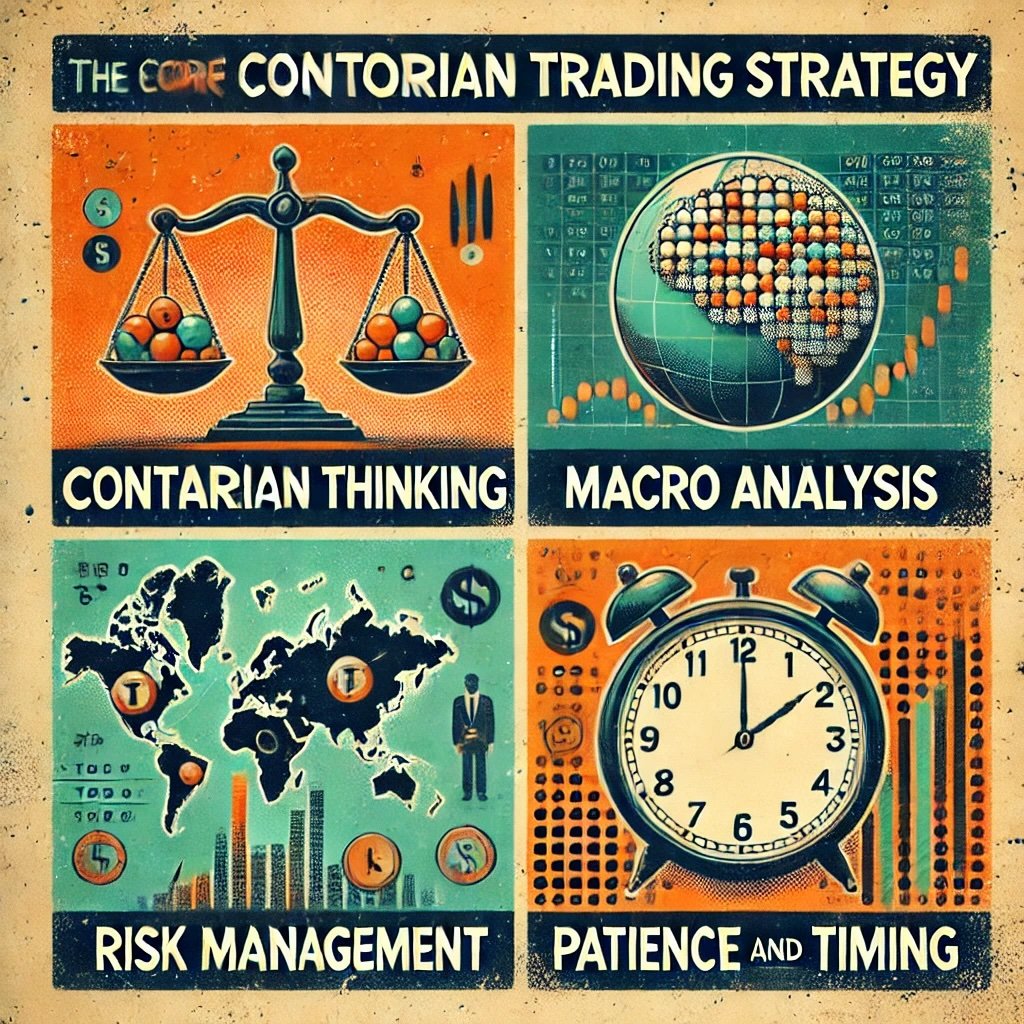
Core Principles of Paul Tudor Jones’s Trading Strategy
Contrarian Thinking
Contrarian thinking is the cornerstone of Jones’s trading strategy. This approach involves going against the prevailing market sentiment, identifying opportunities where the majority may be complacent or excessively optimistic/pessimistic. Contrarian traders believe that markets often overreact, leading to price distortions that can be exploited for profit.
Jones employs contrarian thinking by:
- Identifying Overreactions: Recognizing when the market has overextended in either direction, creating opportunities for mean reversion.
- Assessing Market Psychology: Understanding the collective behavior of investors to predict potential reversals.
- Seeking Undervalued or Overvalued Assets: Investing in assets that the market has undervalued or divesting from overvalued ones.
Macro Analysis
Jones’s trading decisions are deeply rooted in macro analysis. He examines broad economic trends, geopolitical developments, and financial data to forecast market movements. This holistic view ensures that his trades are informed by a comprehensive understanding of global factors, rather than being confined to short-term market fluctuations.
Key components of his macro analysis include:
- Economic Data Evaluation: Analyzing indicators such as GDP growth, unemployment rates, and inflation to assess economic health.
- Geopolitical Assessment: Evaluating the impact of political events, international relations, and policy changes on markets.
- Sector Analysis: Identifying sectors poised for growth or decline based on macroeconomic trends.
By integrating these elements, Jones can anticipate shifts in market dynamics and position his portfolio accordingly.
Risk Management
For Jones, risk management is paramount. He emphasizes capital preservation and employs various techniques to control and mitigate risks. Effective risk management ensures that even in adverse market conditions, losses are minimized, and the portfolio remains resilient.
Jones’s risk management strategies include:
- Stop-Loss Orders: Setting predetermined exit points to limit potential losses on any given trade.
- Position Sizing: Determining the appropriate amount to invest in each trade based on the level of risk, ensuring no single investment can disproportionately impact the portfolio.
- Diversification: Spreading investments across various asset classes and geographical regions to mitigate the risk associated with any single market or sector.
Patience and Timing
Patience and timing are critical elements of Jones’s trading approach. He avoids impulsive decisions and waits for optimal market conditions before executing trades. This disciplined approach ensures that investments are made when the probability of favorable outcomes is highest.
Jones’s strategy involves:
- Waiting for Confirmation: Seeking confirmation of his analysis before committing to a trade.
- Avoiding Overtrading: Limiting the number of trades to focus on high-conviction opportunities.
- Strategic Entry and Exit Points: Precisely timing the entry and exit points to maximize returns and minimize risks.
By exercising patience and precise timing, Jones enhances the effectiveness of his trading strategies and ensures sustained profitability.

Famous Trades and Market Calls
Black Monday Trade: A Masterstroke
One of Paul Tudor Jones’s most renowned trades occurred on Black Monday in October 1987. Sensing an impending market crash, Jones took a substantial short position on the S&P 500. When the market plummeted by over 20% in a single day, his foresight not only protected his investments but also generated significant profits.
This trade is often cited as a testament to Jones’s contrarian acumen and strategic brilliance. It exemplifies his ability to anticipate market downturns and act decisively to capitalize on them, even when prevailing sentiment was overwhelmingly bullish.
Other Significant Trades
Beyond Black Monday, Jones has made several other notable trades that reflect his strategic mindset:
- Japanese Yen and Japanese Stocks:Anticipating the bursting of the Japanese asset bubble in the early 1990s, Jones positioned himself to benefit from the subsequent decline in Japanese stocks and the Yen. This move underscored his ability to identify and act on macroeconomic trends long before they become apparent to the broader market.
- Gold and Silver:Jones has effectively utilized precious metals like gold and silver as part of his portfolio diversification strategy. By capitalizing on shifts in commodity prices, he has hedged against inflation and economic uncertainty, enhancing the resilience of his investments.
- Emerging Markets:Identifying growth opportunities in emerging economies, Jones has leveraged macro trends to enhance returns. His investments in regions poised for economic expansion have yielded substantial profits, demonstrating his keen eye for potential in underappreciated markets.
Lessons from These Trades
These trades offer several valuable lessons:
- Anticipate Market Shifts: Successful trading often involves foreseeing changes before they become evident to the broader market.
- Diversification is Key: Spreading investments across various asset classes and regions mitigates risk and enhances portfolio resilience.
- Strategic Positioning: Taking calculated positions based on thorough analysis can yield significant rewards, even in volatile or declining markets.
- Discipline and Timing: Exercising patience and precise timing in executing trades ensures that investments are made under optimal conditions, maximizing potential returns.
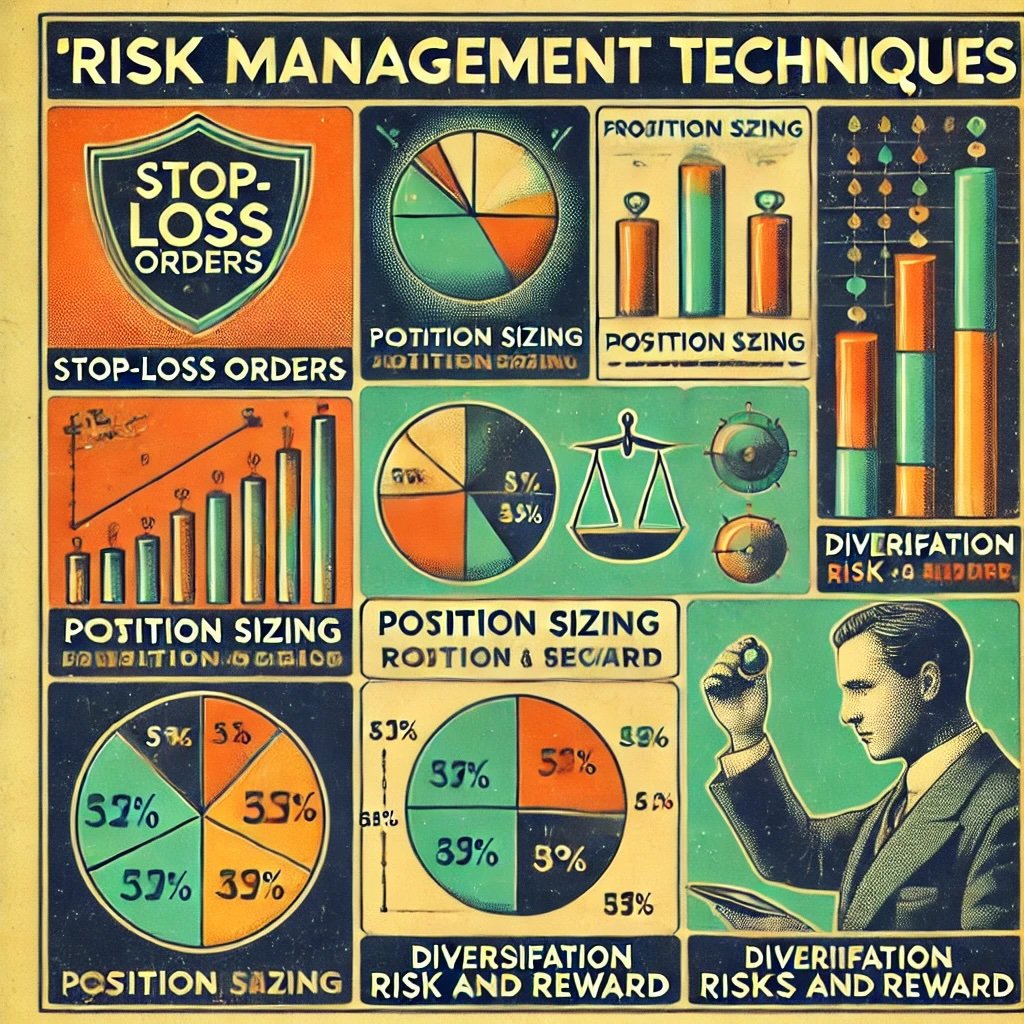
Risk Management Techniques
Jones’s Approach to Risk Management
Risk management is not merely a component of Jones’s strategy—it is the foundation upon which his trading philosophy is built. He prioritizes capital preservation and employs a multi-faceted approach to control and mitigate risks, ensuring that his portfolio remains robust even in adverse market conditions.
Stop-Loss Orders
Stop-loss orders are a critical tool in Jones’s risk management arsenal. By setting predetermined exit points, he limits potential losses on any given trade. This disciplined approach prevents emotional decision-making and safeguards the portfolio from significant downturns.
Implementation Tips:
- Determine Risk Tolerance: Assess how much you’re willing to lose on a trade and set stop-loss levels accordingly.
- Use Technical Analysis: Identify support and resistance levels to place stop-loss orders strategically.
- Avoid Emotional Attachment: Stick to the stop-loss levels to maintain discipline, regardless of market volatility.
Position Sizing
Position sizing involves determining the appropriate amount to invest in each trade based on the level of risk. Jones carefully calibrates his positions to ensure that no single investment can disproportionately impact his overall portfolio.
Best Practices:
- Risk-Per-Trade: Allocate a fixed percentage of your portfolio to each trade, limiting exposure to any single investment.
- Diversify Investments: Spread investments across different asset classes and sectors to balance risk.
- Adjust Based on Volatility: Increase or decrease position sizes based on the volatility of the asset being traded.
Diversification
Diversification is another cornerstone of Jones’s strategy. By spreading investments across various asset classes, geographical regions, and sectors, he mitigates the risk associated with any single market or sector.
Effective Diversification Strategies:
- Asset Class Diversification: Invest in a mix of equities, bonds, commodities, and currencies.
- Geographical Diversification: Allocate investments across different regions to reduce exposure to localized economic downturns.
- Sector Diversification: Spread investments across various industries to balance sector-specific risks.
Balancing Risk and Reward
Jones adeptly balances risk and reward by evaluating the potential upside against the possible downside for each trade. This meticulous evaluation ensures that his investments offer favorable risk-reward ratios, enhancing the likelihood of sustained profitability.
Strategies for Balancing Risk and Reward:
- Risk-Reward Ratio: Aim for trades where the potential reward outweighs the risk, such as a 2:1 or 3:1 ratio.
- Thorough Analysis: Conduct comprehensive research to assess the viability and potential returns of each investment.
- Regular Portfolio Review: Continuously monitor and adjust the portfolio to maintain an optimal balance between risk and reward.

The Role of Psychology in Trading
Understanding the Psychological Landscape
Paul Tudor Jones recognizes that psychology plays a pivotal role in trading. The ability to maintain emotional control and discipline is essential for making rational decisions, especially in high-stakes environments. Emotions like fear and greed can cloud judgment, leading to impulsive and often detrimental trading decisions.
Maintaining Discipline and Emotional Control
To stay disciplined, Jones employs several strategies:
- Routine and Structure:Establishing consistent trading routines minimizes emotional interference. By adhering to a structured approach, Jones ensures that his decisions are guided by strategy rather than emotions.
- Mindfulness Practices:Engaging in activities like meditation enhances focus and reduces stress, enabling Jones to maintain clarity during volatile market conditions.
- Objective Decision-Making:Relying on data and analysis rather than emotions ensures that trading decisions are rational and informed.
Self-Awareness and Adaptability
Self-awareness allows Jones to recognize his own biases and tendencies, ensuring that they don’t cloud his judgment. Understanding one’s psychological strengths and weaknesses is crucial for maintaining objectivity in trading.
Adaptability enables Jones to adjust his strategies in response to changing market conditions. The ability to pivot and adapt ensures that his trading approach remains effective across diverse scenarios and evolving markets.
Techniques for Enhancing Trading Psychology
Here are some techniques to bolster trading psychology:
- Journaling:Keeping a trading journal to reflect on decisions and outcomes helps identify patterns and areas for improvement.
- Continuous Learning:Staying informed and educated builds confidence in trading strategies and reduces uncertainty.
- Stress Management:Implementing stress-relief practices, such as exercise or hobbies, maintains mental clarity and emotional balance.
- Visualization:Visualizing successful trades and outcomes fosters a positive mindset and reinforces disciplined behavior.
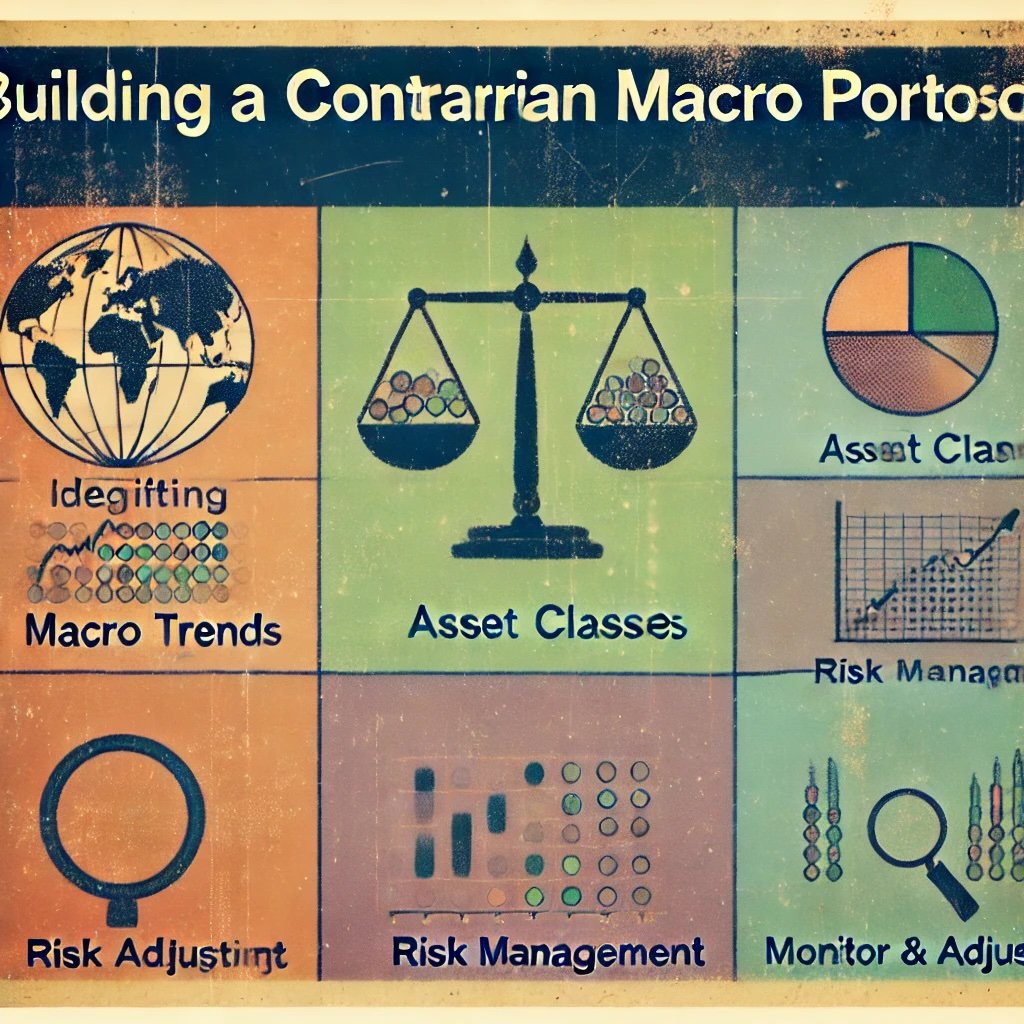
Building a Contrarian Macro Portfolio
Step-by-Step Guide to Construction
Building a contrarian macro portfolio inspired by Paul Tudor Jones involves several key steps:
- Identify Macro Trends:Analyze global economic indicators, geopolitical events, and market sentiments to identify prevailing trends.
- Select Asset Classes:Choose a diverse mix of asset classes such as equities, bonds, commodities, and currencies to ensure broad exposure.
- Apply Contrarian Principles:Take positions opposite to the prevailing market sentiment where justified by thorough analysis.
- Implement Risk Management:Utilize stop-loss orders, position sizing, and diversification to manage and mitigate risks effectively.
- Monitor and Adjust:Continuously monitor the portfolio and make adjustments based on evolving market conditions and new information.
Asset Allocation Strategies
Effective asset allocation based on macroeconomic themes includes:
- Economic Growth:Investing in sectors poised to benefit from economic expansion, such as technology, consumer discretionary, and industrials.
- Inflation Hedge:Allocating to assets like gold, real estate, and inflation-protected securities that typically perform well during inflationary periods.
- Currency Plays:Taking positions in currencies expected to appreciate or depreciate based on macroeconomic trends and central bank policies.
- Geopolitical Bets:Investing in regions or sectors influenced by geopolitical developments, such as defense stocks during periods of increased global tension.
Tips for Monitoring and Adjusting the Portfolio
- Regular Review:Schedule periodic reviews to assess portfolio performance and evaluate the impact of macroeconomic changes.
- Stay Informed:Keep abreast of global news, economic reports, and market analyses that could impact your investments.
- Flexible Strategies:Be prepared to pivot your strategies in response to new information or changing trends to maintain portfolio effectiveness.
- Performance Tracking:Use metrics and analytics tools to evaluate the effectiveness of your investment choices and make data-driven adjustments.
Sample Contrarian Macro Portfolio Allocation
Here’s an example of how a contrarian macro portfolio inspired by Paul Tudor Jones might be allocated:
- Equities (40%):
- Domestic Stocks: Focus on undervalued sectors or companies poised for recovery.
- International Stocks: Invest in emerging markets or regions experiencing economic shifts.
- Bonds (20%):
- Government Bonds: Safe-haven assets during periods of market uncertainty.
- Corporate Bonds: Higher yields with manageable risk.
- Commodities (20%):
- Gold and Precious Metals: Hedge against inflation and economic instability.
- Energy Commodities: Capitalize on geopolitical events affecting energy markets.
- Currencies (10%):
- USD/Other Major Currencies: Take positions based on anticipated central bank policies.
- Emerging Market Currencies: Leverage macroeconomic trends in developing economies.
- Alternative Investments (10%):
- Real Estate: Invest in properties or REITs benefiting from economic trends.
- Hedge Funds: Gain exposure to diverse strategies and asset classes.
Challenges of Contrarian Macro Trading
Potential Pitfalls
Adopting a contrarian macro strategy comes with its set of challenges:
- Market Timing:Accurately predicting market turns is inherently difficult. Misjudging the timing can lead to significant losses.
- Emotional Strain:Going against the crowd can be psychologically taxing, especially during periods of sustained market momentum contrary to your position.
- Complex Analysis:Requires a deep understanding of macroeconomic factors and their interplay, which can be resource-intensive and time-consuming.
- Resource Intensive:Demands continuous research and monitoring of global markets, economic indicators, and geopolitical events.
Overcoming Common Challenges
To navigate these challenges, consider the following strategies:
- Robust Research:Invest time in thorough analysis to inform your contrarian positions. Utilize reputable sources and analytical tools to enhance your understanding.
- Emotional Resilience:Develop mental toughness to withstand periods of underperformance or skepticism. Practices like meditation and maintaining a trading journal can aid in emotional management.
- Continuous Education:Stay updated on economic theories, market dynamics, and emerging trends to enhance your analytical capabilities and adapt to evolving markets.
- Leverage Technology:Utilize advanced tools and platforms to streamline research, data analysis, and portfolio management processes, increasing efficiency and accuracy.
Staying Informed and Adaptable
The financial markets are ever-evolving, influenced by a multitude of factors that can change rapidly. Staying informed through reliable sources and being adaptable in your strategies are crucial for sustaining success in contrarian macro trading.
Strategies for Staying Informed and Adaptable:
- Subscribe to Financial News:Regularly follow reputable financial news outlets like Bloomberg, Financial Times, and The Wall Street Journal.
- Attend Seminars and Webinars:Participate in industry seminars, webinars, and conferences to gain insights from experts and stay abreast of the latest trends.
- Network with Professionals:Engage with other traders, analysts, and financial professionals to exchange ideas and perspectives.
- Regular Strategy Reviews:Periodically assess and refine your trading strategies to ensure they remain aligned with current market conditions and your investment goals.
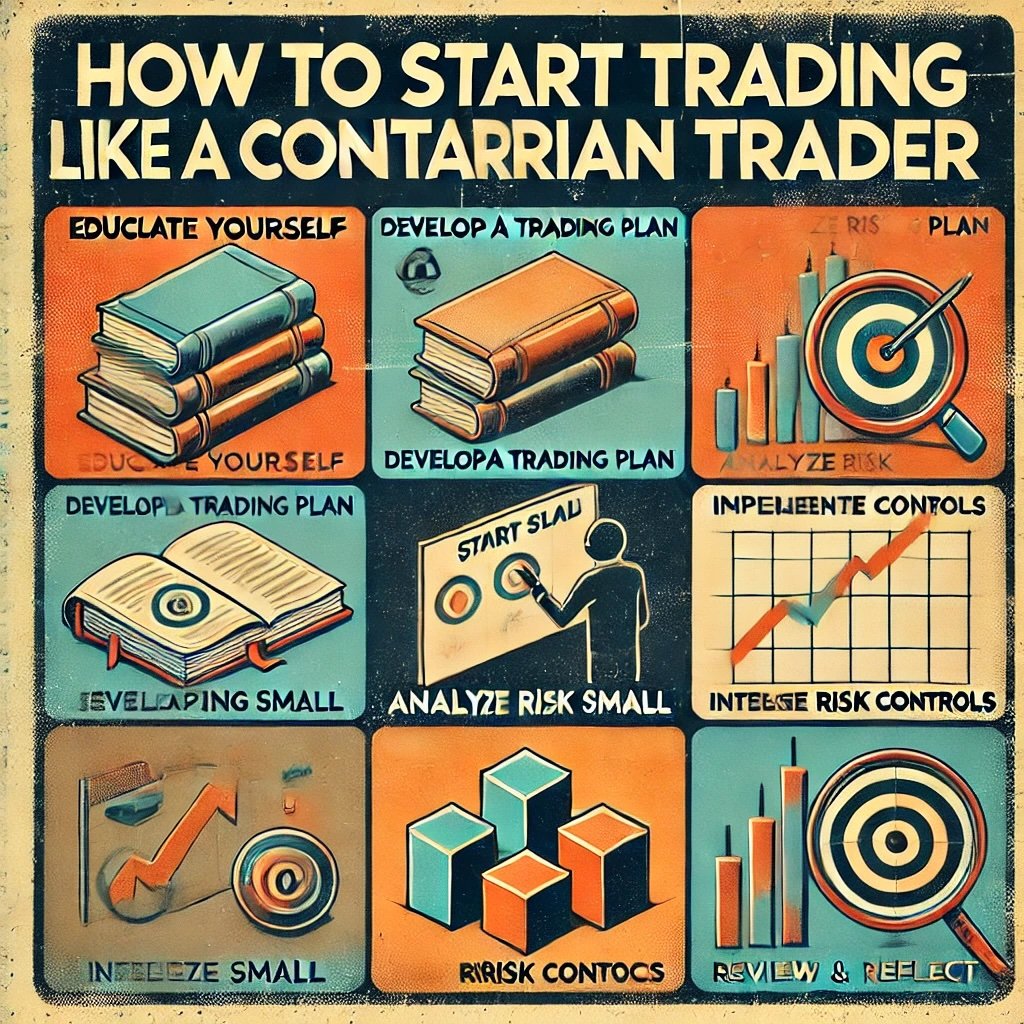
How to Start Trading Like Paul Tudor Jones
Practical Steps to Implement Jones’s Strategies
Embarking on a trading journey inspired by Paul Tudor Jones requires a structured and disciplined approach. Here are practical steps to help you implement his strategies:
- Educate Yourself:Begin with a solid foundation in macroeconomics and financial markets. Understanding the broader economic landscape is crucial for making informed trading decisions.
- Develop a Trading Plan:Outline your investment goals, strategies, and risk management protocols. A well-defined trading plan serves as a roadmap, guiding your decisions and actions.
- Start Small:Begin with smaller positions to gain experience without exposing yourself to significant risk. Gradually scale up as you become more comfortable and confident in your strategies.
- Analyze Markets:Use macroeconomic indicators and market signals to identify potential contrarian opportunities. Conduct thorough research to validate your investment hypotheses.
- Implement Risk Controls:Set stop-loss orders and determine appropriate position sizes for each trade. Effective risk controls are essential for protecting your capital and ensuring long-term success.
- Review and Reflect:Regularly assess your trades and strategies, learning from successes and mistakes. Continuous reflection and adaptation enhance your trading acumen and performance.
Resources for Further Learning
To deepen your understanding of macroeconomic analysis and contrarian trading, consider the following resources:
- Books:
- Market Wizards by Jack D. Schwager
- The Alchemy of Finance by George Soros
- Trading for a Living by Dr. Alexander Elder
- Reminiscences of a Stock Operator by Edwin Lefèvre
- Online Courses:
- Coursera’s Global Financial Markets and Instruments: Offers comprehensive insights into global financial markets and their functioning.
- Investopedia’s Advanced Trading Strategies: Provides detailed strategies and techniques for advanced traders.
- edX’s Economics for Business: Covers essential economic principles applicable to trading and investment.
- Websites and Journals:
- Bloomberg: Offers real-time financial news, data, and analysis.
- The Wall Street Journal: Provides comprehensive coverage of financial markets and economic trends.
- Financial Times: Delivers global financial news and insights.
- Seeking Alpha: Features investment research, analysis, and market commentary.
Tools and Platforms
Leveraging the right tools is essential for supporting your contrarian macro trading strategies. Here are some recommended tools and platforms:
- Trading Platforms:
- Thinkorswim: Offers advanced trading tools and comprehensive market data.
- MetaTrader 5: Provides robust charting capabilities and automated trading features.
- Interactive Brokers: Known for its extensive range of tradable assets and low commission rates.
- Analytical Tools:
- Bloomberg Terminal: Provides in-depth financial data, analytics, and trading tools.
- TradingView: Offers powerful charting tools and a vibrant community of traders.
- Eikon by Refinitiv: Delivers real-time market data and analytics for informed trading decisions.
- Data Sources:
- Federal Reserve Economic Data (FRED): A comprehensive database of economic data and indicators.
- World Bank: Provides global economic data and development indicators.
- International Monetary Fund (IMF): Offers detailed reports and data on global economic trends.
Building Analytical Skills
To effectively implement contrarian macro trading strategies, developing strong analytical skills is essential. Focus on:
- Economic Analysis:Understand how macroeconomic indicators like GDP, inflation, and unemployment rates influence market movements.
- Technical Analysis:Learn to interpret charts, patterns, and technical indicators to identify potential entry and exit points.
- Geopolitical Analysis:Assess the impact of political events, international relations, and policy changes on global markets.
- Quantitative Analysis:Develop proficiency in statistical methods and data analysis to evaluate investment opportunities objectively.
Paul Tudor Jones (Contrarian Macro Trader): 12-Question FAQ
Who is Paul Tudor Jones and why is he influential?
Founder of Tudor Investment Corp, Jones is known for contrarian, macro-driven trades, rigorous risk control, and legendary crisis navigation (e.g., 1987), inspiring generations of discretionary global macro traders.
What defines “contrarian macro” in Jones’s style?
Taking positions against consensus when macro, policy, and sentiment data imply mispricing—then sizing and managing risk so you can be early without being ruined.
Which inputs matter most in his macro process?
Policy (central banks/fiscal), growth/inflation cycles, positioning/sentiment, valuation extremes, inter-market signals (rates, FX, credit, commodities), and price action confirmation.
How does he generate trade ideas?
Form a top-down thesis (e.g., policy shift → cycle turn), map best expression (futures, FX, options, commodities, indices), and wait for price to agree before committing size.
How are entries timed?
Price triggers (breaks/trend resumption), catalysts (policy meetings/data), and asymmetric option structures to risk small for potentially large payoffs when fading consensus.
How are exits managed?
Pre-defined invalidation (thesis breaks), trailing stops around key levels/volatility, scaling out into targets or when positioning/sentiment normalizes.
How does he size risk?
Small on initial probe, scale on confirmation; cap per-trade risk and overall “portfolio heat”; adjust size to volatility and correlation so one theme can’t dominate.
What role does optionality play?
Options express contrarian views with defined downside and convex upside, especially around catalysts or when timing uncertainty is high.
What are common pitfalls for would-be contrarians?
Fighting trends without a catalyst, oversizing early, ignoring positioning/sentiment, anchoring to narratives after price invalidates the thesis.
How can a retail investor apply this playbook?
Write a macro IPS (signals, triggers, sizing, exits), track a dashboard (growth, inflation, policy, positioning), use ETF/futures/options, start small, and review on a schedule.
How should the approach adapt to modern markets?
Respect faster flows/algos: stronger liquidity filters, realistic slippage, scenario trees for policy paths, and risk premia that shift with regime changes.
What performance profile should be expected?
Uneven: small scratches and stop-outs, punctuated by occasional large winners when regime shifts occur; patience and capital preservation are essential.
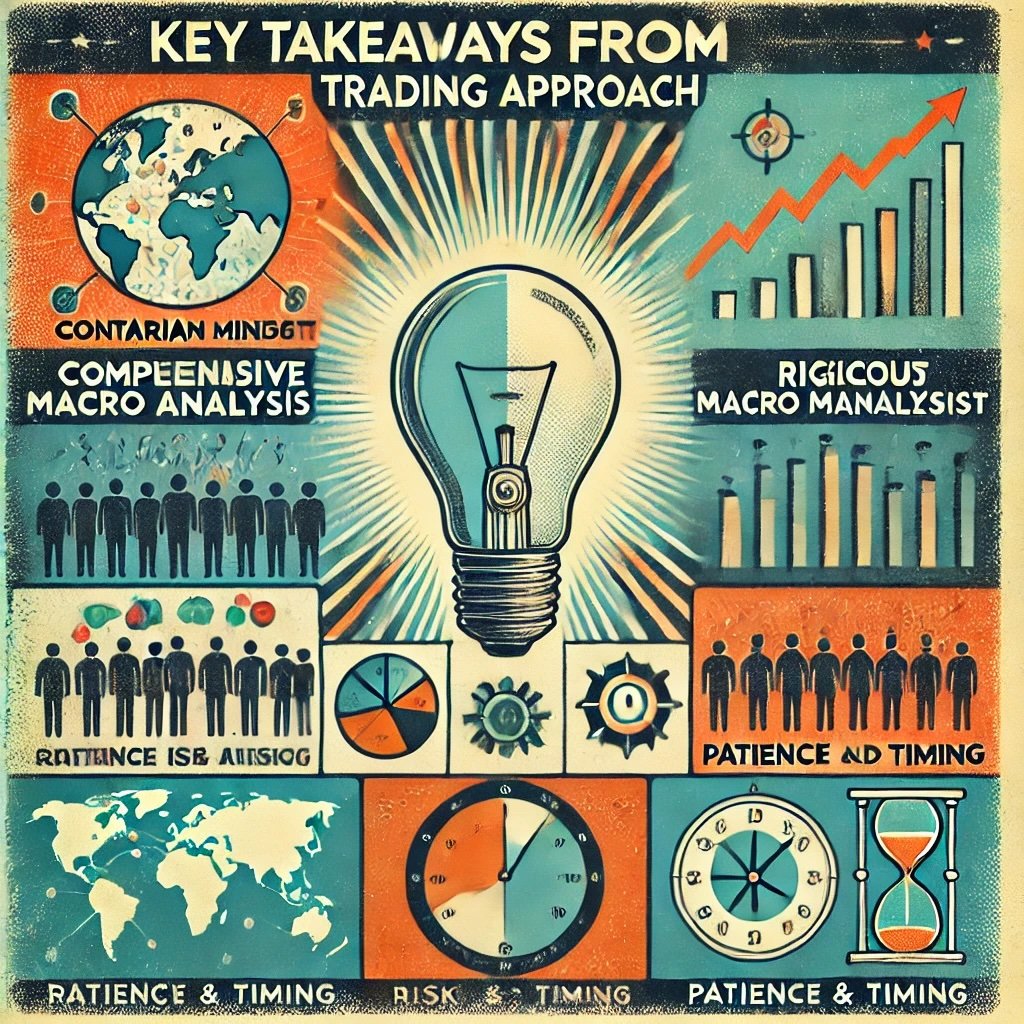
Key Takeaways from Paul Tudor Jones’s Trading Approach
- Contrarian Mindset:Embrace opportunities by thinking differently from the majority. Recognize that markets often overreact, creating price discrepancies that can be exploited for profit.
- Comprehensive Macro Analysis:Base your decisions on a thorough understanding of global economic and geopolitical factors. A holistic view ensures that your investments are informed and strategic.
- Rigorous Risk Management:Prioritize capital preservation through disciplined risk control techniques. Effective risk management safeguards your portfolio against significant losses.
- Patience and Timing:Wait for optimal conditions before executing trades. Strategic entry and exit points enhance the likelihood of favorable outcomes.
Viability of Contrarian Macro Trading for Different Investors
Contrarian macro trading, as exemplified by Paul Tudor Jones, offers a robust framework for investors seeking to outperform the market. While it requires a deep understanding of macroeconomics and a disciplined approach, the potential rewards can be substantial. This strategy is suitable for:
- Experienced Traders:Those with a solid foundation in macroeconomic analysis and trading experience can effectively implement contrarian strategies.
- Intermediate Investors:Investors with some market experience can adopt elements of contrarian trading, gradually building their expertise.
- Long-Term Investors:Those with a long-term investment horizon can benefit from the strategic positioning and diversification inherent in contrarian macro trading.
However, it is essential to recognize that contrarian strategies involve higher risk and require continuous learning and adaptability. Investors should assess their risk tolerance and investment goals before adopting this approach.
Explore and Experiment
Embarking on a contrarian macro trading journey inspired by Paul Tudor Jones is both challenging and rewarding. It encourages critical thinking, continuous learning, and disciplined execution—qualities that are essential for sustained success in the financial markets. As you explore these strategies, remember to:
- Stay Informed: Continuously educate yourself on macroeconomic trends and market dynamics.
- Maintain Discipline: Adhere to your trading plan and risk management protocols, avoiding impulsive decisions.
- Be Adaptable: Remain flexible and willing to adjust your strategies in response to changing market conditions.
- Reflect and Learn: Regularly review your trades and strategies, learning from both successes and mistakes.
By embracing the principles and strategies of Paul Tudor Jones, you can navigate the complexities of financial markets with confidence and strategic insight. Remember, investing is a journey—stay committed, stay informed, and stay disciplined.
Investing like Paul Tudor Jones isn’t just about following a set of rules; it’s about cultivating a mindset that seeks opportunities where others see obstacles. By embracing contrarian macro trading principles, you can navigate the complexities of financial markets with confidence and strategic insight. Happy trading!
Important Information
Comprehensive Investment Disclaimer:
All content provided on this website (including but not limited to portfolio ideas, fund analyses, investment strategies, commentary on market conditions, and discussions regarding leverage) is strictly for educational, informational, and illustrative purposes only. The information does not constitute financial, investment, tax, accounting, or legal advice. Opinions, strategies, and ideas presented herein represent personal perspectives, are based on independent research and publicly available information, and do not necessarily reflect the views or official positions of any third-party organizations, institutions, or affiliates.
Investing in financial markets inherently carries substantial risks, including but not limited to market volatility, economic uncertainties, geopolitical developments, and liquidity risks. You must be fully aware that there is always the potential for partial or total loss of your principal investment. Additionally, the use of leverage or leveraged financial products significantly increases risk exposure by amplifying both potential gains and potential losses, and thus is not appropriate or advisable for all investors. Using leverage may result in losing more than your initial invested capital, incurring margin calls, experiencing substantial interest costs, or suffering severe financial distress.
Past performance indicators, including historical data, backtesting results, and hypothetical scenarios, should never be viewed as guarantees or reliable predictions of future performance. Any examples provided are purely hypothetical and intended only for illustration purposes. Performance benchmarks, such as market indexes mentioned on this site, are theoretical and are not directly investable. While diligent efforts are made to provide accurate and current information, “Picture Perfect Portfolios” does not warrant, represent, or guarantee the accuracy, completeness, or timeliness of any information provided. Errors, inaccuracies, or outdated information may exist.
Users of this website are strongly encouraged to independently verify all information, conduct comprehensive research and due diligence, and engage with qualified financial, investment, tax, or legal professionals before making any investment or financial decisions. The responsibility for making informed investment decisions rests entirely with the individual. “Picture Perfect Portfolios” explicitly disclaims all liability for any direct, indirect, incidental, special, consequential, or other losses or damages incurred, financial or otherwise, arising out of reliance upon, or use of, any content or information presented on this website.
By accessing, reading, and utilizing the content on this website, you expressly acknowledge, understand, accept, and agree to abide by these terms and conditions. Please consult the full and detailed disclaimer available elsewhere on this website for further clarification and additional important disclosures. Read the complete disclaimer here.



